Odaberite jezik:
ST oprema & Tehnologija D.O.O. (STET) Tribo-elektrostatička tehnologija separatora remena omogućuje Dobročinstvo finog minerala prašci s potpuno suhom tehnologijom pri visokoj propusnosti. STET separator je pogodan za odvajanje vrlo fino (<1µm) za umjereno gruba (500µm) Čestice, za razliku od drugih procesa elektrostatičkog odvajanja koji su obično ograničeni na čestice >75μm u veličini. STET je uspješno dobročinio uzorke željezne rude, uključujući rudače mina, repovi i itabirit sa sadržajem željezne hrane u rasponu od 30-55%. Eksperimentalni nalazi pokazuju da se željezne rude niskog stupnja mogu nadograditi na komercijalne razrede (58-65% Fe) dok istovremeno odbacuje silicijev dioksid pomoću separatora STET remena. Ovdje, prikazan je kompendij eksperimentalnih rezultata i preliminarna studija potencijalnih primjena STET tehnologije za željeznu industriju. Preliminarne studije uključuju dijagrame toka na visokoj razini i ekonomske procjene za odabrane zahtjeve. Raspravlja se i o izazovima povezanima s usvajanjem tehnologije i usporedbom s trenutačno dostupnim tehnologijama za preradu novčanih kazni za željeznu rudu.
1.0 Uvod
Željezna ruda je četvrti najčešći element u zemljinoj kori i neophodna je za globalni gospodarski razvoj i proizvodnju čelika [1-2]. Željezne rude imaju širok raspon u kemijskom sastavu, posebno za sadržaj Fe i povezane minerale gangue [1]. Glavni minerali koji nose željezo su hematit, Getit, limonit i magnetit [1,3] a glavni zagađivači u željeznim rudama su: 2 i Al2O3. Svaki mineral depozit ima svoje jedinstvene karakteristike u odnosu na željezo i Gangu ležaja minerala, i stoga zahtijeva drugačiju tehniku koncentracije [4].
Moderni krugovi obrade minerala željeznog ležaja mogu uključivati gravimetrijsku koncentraciju, magnetska koncentracija, i koraci flotacije [1,3]. Međutim, Moderni krugovi predstavljaju izazove u smislu obrade novčanih kazni i sluzi željezne rude [4-6]. Gravimetrijske tehnike poput spirala ograničene su veličinom čestica i smatraju se samo učinkovitim načinom koncentracije hematita i magnetita za frakciju veličine iznad 75 μm [5]. Mokro i suho magnetsko odvajanje niskog intenziteta (Lims (lims)) Tehnike se koriste za obradu visokokvalitetnih željeznih ruda s jakim magnetskim svojstvima kao što je magnetit, dok se mokro magnetsko odvajanje visokog intenziteta koristi za odvajanje minerala željeznog ležaja sa slabim magnetskim svojstvima kao što je hematit od gangue minerala. Magnetske metode predstavljaju izazove zbog njihove potrebe da željezna ruda bude osjetljiva na magnetska polja [3]. Flotacija se koristi za smanjenje sadržaja nečistoća u željeznim rudama niskog stupnja, ali je ograničen cijenom reagensa, i prisutnost silicijevog dioksida, sluzi bogate glinicom i karbonatni minerali [4,6]. U nedostatku daljnje silazne obrade za tokove odbacivanja, fino odlaganje željeza završit će u brani s repom [2].
Odlaganje repova i obrada željeznih novčanih kazni postali su ključni za očuvanje okoliša i oporabu željeznih dragocjenosti, odnosno, Stoga je prerada repova željezne rude i novčanih kazni u rudarskoj industriji postala sve važnija[7].
Međutim, Obrada željeznih repova i novčanih kazni i dalje je izazovna putem tradicionalnih dijagrama toka te stoga mogu postati zanimljive alternativne tehnologije dobročinstva, kao što je odvajanje tribo-elektrostatika, koje je manje ograničavajuće u pogledu mineralogije rude i veličine čestica;. Suha elektrostatička obrada željezne rude predstavlja priliku za smanjenje troškova i stvaranje mokrih repova povezanih s tradicionalnom gravimetrijskom, flotacijski i mokri magnetski separacijski krugovi.
STET je razvio proces odvajanja koji omogućuje učinkovito odvajanje pepela i minerala prema njihovom odgovoru kada su izloženi određenom električnom polju. Tehnologija je uspješno primijenjena na industriju pepela i industriju industrijskih minerala; i STET trenutno istražuje druga otvaranja tržišta gdje bi njihovi separatori mogli ponuditi konkurentsku prednost. Jedno od ciljanih tržišta je nadogradnja fine željezne rude.
STET je proveo istraživačke studije s nekoliko željeznih ruda, a eksperimentalni rezultati do danas pokazali su da se novčane kazne željezne rude niskog stupnja mogu nadograditi pomoću STET tribo-elektrostatičkog separatora remena. Stet suhi elektrostatični proces odvajanja nudi mnoge prednosti u odnosu na tradicionalne metode mokre obrade, uključujući sposobnost oporavka finog i ultra finog željeza koje bi inače bilo izgubljeno zbog repova ako se obrađuje postojećom tehnologijom. osim toga, tehnologija ne zahtijeva potrošnju vode, što rezultira eliminacijom crpljenja, zadebljanje i sušenje, kao i sve troškove i rizike povezane s liječenjem i zbrinjavanju vode; Nema odlaganja mokrih repova – nedavni visokoprofilni kvarovi brana na repu istaknuli su dugoročni rizik od skladištenja mokrih repova; i, nije potrebna dodatna kemikalija, što stoga negira tekuće troškove reagensa i pojednostavljuje dopuštanje.
Željezna ruda je industrija s dinamikom koja se razlikuje od ostalih osnovnih metala. To je zbog fluktuirajućeg tržišta, ogroman obujam proizvodnje i odgovarajući troškovi kako na kapitalnoj tako i na operativnoj strani [8] kao i nepostojanje središnjih čvorišta za razmjenu kao što je Londonska burza metala. To se pretvara u ogromne prinose koji su mogući kada cijena raketira prema gore i tanke marže kada su okolnosti prljavije. To je jedan od razloga ogromnog obujma proizvodnje i naglaska na niske jedinične troškove proizvodnje.
Ovdje, prikazani su rezultati probirne studije industrije željezne rude koju su razvili STET i Soutex kako bi se identificirale niše u kojima bi STET tehnologija mogla ponuditi ekonomsku prednost u usporedbi s konvencionalnijim tehnologijama. Soutex je konzultantska tvrtka za preradu minerala i metalurgiju i ima iskustvo u dizajniranju, optimiziranje i rad različitih procesa koncentracije željezne rude, uz razumijevanje CAPEX-a, OPEX kao i marketinški aspekti industrije željezne rude. Za ovu studiju, Soutex je pružio svoju stručnost u procjeni potencijalnih primjena za odvajanje triboelektrostata u željeznoj rudi. Opseg Soutexa uključivao je razvoj listova toka i procjenu kapitala na razini studije veličine i procjene operativnih troškova. Ovaj rad istražuje tri najperspektivnije pronađene aplikacije, na tehničkoj i ekonomskoj razini. Ta tri zahtjeva utvrđena su kao: Nadogradnja novčanih kazni za željeznu rudu u australskom rudarstvu DSO-a; čišćenje finog koncentrata željeza u koncentratorima hematita/magnetita; i, ponovna obrada bogatih repova brazilskih operacija.
2.0 STET triboelektronstatski separator remena
Pokusi su provedeni pomoću tribo-elektrostatskog separatora remena na klupi. Ispitivanje na klupi prva je faza trofaznog procesa implementacije tehnologije, uključujući evaluaciju na klupi, pilot-testiranje i provedba komercijalnih razmjera. Separator klupe koristi se za probir kao dokaz tribo-elektrostatičkog punjenja i za utvrđivanje je li materijal dobar kandidat za elektrostatičko dobročinstveno. Glavne razlike između svakog komada opreme prikazane su u tablici 1. Iako se oprema koja se koristi unutar svake faze razlikuje po veličini, princip operacije u osnovi je isti.
STET je procijenio nekoliko uzoraka željezne rude na klupama i uočeno je značajno kretanje željeza i odbacivanje silikata (Vidi tablicu 2). Eksperimentalni uvjeti odabrani su tako da se oporavi željezo u odnosu na. krivulja povećanja željeza mogla bi se izvući i kasnije upotrijebiti kao ulazni element za operativni gospodarski model
Tablica 2. Rezultati na klupama na različitim željeznim rudama
| Exp | Hraniti Fe wt.% | Proizvod Fe wt.% | Apsolutni fe Porast % | Fe Oporavak % | SiO2 Odbijanje % | D10 (µm) | D50 (µm) | D90 (µm) |
|---|---|---|---|---|---|---|---|---|
| 1 | 39.2 | 50.6 | 11.4 | 91.5 | 63.9 | 5 | 23 | 59 |
| 2 | 39.4 | 60.5 | 21.1 | 50.8 | 96.0 | 5 | 23 | 59 |
| 3 | 30.1 | 48.0 | 17.9 | 70.6 | 84.6 | 1 | 18 | 114 |
| 4 | 29.9 | 54.2 | 24.3 | 56.4 | 93.7 | 1 | 18 | 114 |
| 5 | 47.0 | 50.2 | 3.2 | 96.6 | 35.3 | 17 | 62 | 165 |
| 6 | 21.9 | 48.9 | 27.0 | 41.2 | 96.6 | 17 | 62 | 165 |
| 7 | 47.6 | 60.4 | 12.8 | 85.1 | 96.9 | 17 | 62 | 165 |
| 8 | 35.1 | 44.9 | 9.8 | 89.0 | 54.2 | 3 | 61 | 165 |
| 9 | 19.7 | 37.4 | 17.7 | 76.0 | 56.8 | 5 | 103 | 275 |
| 10 | 54.5 | 62.5 | 8.0 | 86.3 | 77.7 | 5 | 77 | 772 |
| 11 | 54.6 | 66.5 | 11.9 | 82.8 | 95.6 | 8 | 45 | 179 |
(Pogledajte sekciju 3.0, Slika 4). Dodatni eksperimentalni rezultati koji pokazuju rezultate separacije na uzorcima željezne rude pomoću STET tehnologije prikazani su u prethodnoj publikaciji STET-a o obradi željezne rude [9].
Tablica 1. Trofazni postupak implementacije pomoću STET tribo-elektrostatičke tehnologije separatora remena.
| Faza | Koristi se za: | Duljina elektrode | Vrsta procesa |
|---|---|---|---|
| 1- Ljestvica klupa Evaluacija | Kvalitativna Evaluacija | 250cm | Gomila |
| 2- Pilot ljestvica Testiranje | Kvantitativan evaluacija | 610cm | Gomila |
| 3- Komercijalni Vaga | Komercijalni Proizvodnja | 610cm | Kontinuiran |
Kao što se može vidjeti u tablici 1, glavna razlika između separatora na stolu i separatora pilotske i komercijalne ljestvice je u tome što je duljina separatora na stolu približno 0.4 duljine pilot-razmjera i komercijalnih jedinica. Budući da je učinkovitost separatora funkcija duljine elektrode, ispitivanje na stolnim skalama ne može se koristiti kao zamjena za testiranje na pilot-ljestvici. Ispitivanje pilot-skale potrebno je kako bi se utvrdio opseg razdvajanja koje STET proces može postići na komercijalnoj razini, i utvrditi može li stet proces ispuniti ciljeve proizvoda u skladu s danim stopama hrane za životinje. Zbog razlike u duljini aktivnog odvajanja od stolne vage do pilotske vage, Rezultati se obično poboljšavaju na pilot skali.
2.1 Princip rada
U tribo-elektrostatskom separatoru remena (vidi sliku 1 i slika 2), materijal je hranjen u tanke jaz 0.9 – 1.5 cm između dvije paralelne ravne ravne elektrode.
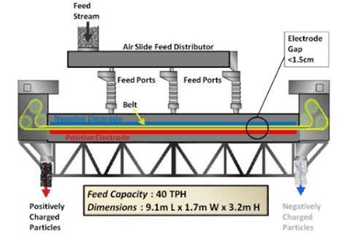 Čestice triboelectrically naplaćuje se po interparticle kontakt. Na primjer, u slučaju uzorka željeza koji se sastoji uglavnom od mineralnih čestica hematita i kvarca, pozitivno naplaćeno (hematit) i negativno
Čestice triboelectrically naplaćuje se po interparticle kontakt. Na primjer, u slučaju uzorka željeza koji se sastoji uglavnom od mineralnih čestica hematita i kvarca, pozitivno naplaćeno (hematit) i negativno
okrivljen (kvarc) privlači nasuprot elektrode. Čestice se zatim pomiču kontinuiranom pokretnom otvorenom mrežastom trakom i prenose u suprotnim smjerovima. Pojas potezi čestice uz svake elektrode prema suprotnim stranama razdjelnika. Protok protustruje razdjelnih čestica i kontinuirano triboelektrično punjenje sudarima čestica i čestica omogućuju višestupanjsko odvajanje i rezultiraju izvrsnom čistoćom i oporavkom u jednoprolaznoj jedinici. Remen omogućuje obradu finih i ultra finih čestica, uključujući čestice manje od 20μm, Pružanjem metode kontinuiranog čišćenja površine elektroda i uklanjanja sitnih čestica, koji bi se inače lijepili za površinu elektroda. Velika brzina remena također omogućuje propusnosti do 40 tona na sat na jednom separatoru kontinuiranim prijenosom materijala iz separatora. Kontroliranjem raznih parametara procesa, uređaj omogućuje optimizaciju mineralne kvalitete i oporavak.
Razdjelnik je relativno jednostavna. Pojas i povezan valjci su jedini dijelovi. Elektrode su stacionarne i sastoje se od vrlo izdržljivog materijala. Remen je potrošni dio koji zahtijeva rijetku, ali povremenu zamjenu, postupak koji može dovršiti samo jedan operator 45 minuta. Separatora elektroda dužina je oko 6 metara (20 FT.) i širina 1.25 metara (4 FT.) za punu veličinu poslovne jedinice (vidi sliku 3). Potrošnja energije manja je od 2 kWh po toni obrađenog materijala s većinom snage koju troše dva motora koji pokreću remen.
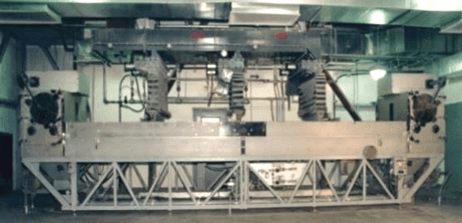 Proces je potpuno suha, zahtijeva nijedan dodatni materijali i proizvodi bez otpadnih voda ili zrak emisija. Za odvajanje minerala separator pruža tehnologiju za smanjenje potrošnje vode, produljiti vijek trajanja pričuve i/ili oporaviti i ponovno obraditi repove.
Proces je potpuno suha, zahtijeva nijedan dodatni materijali i proizvodi bez otpadnih voda ili zrak emisija. Za odvajanje minerala separator pruža tehnologiju za smanjenje potrošnje vode, produljiti vijek trajanja pričuve i/ili oporaviti i ponovno obraditi repove.
Kompaktnost sustav omogućuje fleksibilnost u instalaciju dizajna. Tehnologija odvajanja tribo-elektrostatskog pojasa robusna je i industrijski dokazana te je prvi put industrijski primijenjena na preradu pepela muhe s izgaranjem ugljena u 1995. Tehnologija je učinkovita u odvajanju čestica ugljika od nepotpunog izgaranja ugljena, od staklene alumosilikatnih mineralnih čestica u letećeg pepela. Tehnologija je bila ključna u omogućavanju recikliranja pepela bogatog mineralnog muha kao zamjene cementa u betonskom proizvodnji.
Od 1995, preko 20 milijun tona pepela za muhe proizvoda prerađeno je separatorima STET-a instaliranima u SAD-u. Industrijska povijest odvajanja STET-a pepela navedena je u tablici 3.
U preradi minerala, tehnologija separatora triboelektričnog pojasa korištena je za odvajanje širokog raspona materijala, uključujući kalcit/kvarc, Talk/magnezita, i barita/kvarc.
Tablica 3. Industrijska primjena odvajanja tribo-elektrostatskog pojasa za leteći pepeo
| Korisni programi / elektrane | Lokacija | Početak reklame operacije | Objekt Detalji |
|---|---|---|---|
| Duke Energy – Roxboro stanice | Sjeverna Karolina SAD | 1997 | 2 Razdjelnici |
| Talen energije- Brandon Shores | Maryland SAD | 1999 | 2 Razdjelnici |
| Škotska sila- Longannet kolodvor | Škotska Velika Britanija | 2002 | 1 Razdjelnik |
| Jacksonville Electric-St.. Energetski park rijeke Johns | Florida SAD | 2003 | 2 Razdjelnici |
| Električna energija Južnog Mississippija -R.D. Sutra | Mississippi SAD | 2005 | 1 Razdjelnik |
| Novi Brunswick Power-Belledune | Novi Brunswick Kanada | 2005 | 1 Razdjelnik |
| RWE npower-Didcot stanica | Engleska Velika Britanija | 2005 | 1 Razdjelnik |
| Otok Talen Energy-Brunner | Pennsylvania SAD | 2006 | 2 Razdjelnici |
| Tampa Električno-Big Bend Stanica | Florida SAD | 2008 | 3 Razdjelnici |
| RWE npower-Aberthaw Stanica | Wales UK | 2008 | 1 Razdjelnik |
| EDF Energy-West Burton Station | Engleska Velika Britanija | 2008 | 1 Razdjelnik |
| ZGP (Lafarge Cement /Ciech Janikosoda JV) | Poljska | 2010 | 1 Razdjelnik |
| Koreja Jugoistočna Snaga- Jeongheung | Južna Koreja | 2014 | 1 Razdjelnik |
| PGNiG Termika-Sierkirki | Poljska | 2018 | 1 Razdjelnik |
| Taiheiyo cementna tvrtka-Chichibu | Japan | 2018 | 1 Razdjelnik |
| Armstrong Fly Ash- Cement orla | Filipini | 2019 | 1 Razdjelnik |
| Koreja Jugoistočna Snaga- Samcheonpo | Južna Koreja | 2019 | 1 Razdjelnik |
3.0 Metodologija
Tri (3) Slučajevi su utvrđeni za daljnju evaluaciju i obrađuju se pregledom ekonomskih i rizičnih/prilika na razini studije veličine. Evaluacija se temelji na potencijalnom dobitku koji bi operater uočio uključivanjem tehnologije STET-a u tok svojeg postrojenja.
Učinkovitost STET separatora procjenjuje se prema provedenim ispitivanjima stolne vage (Vidi tablicu 2). Podaci prikupljeni s različitim željeznim rudama omogućili su kalibraciju modela oporavka koji je korišten za predviđanje oporavka za tri (3) studije slučaja. Slika 4 ilustrira ishod modela u smislu performansi i troškova. Povrat željeza označen je izravno na šipkama, protiv osvećenja željeza u �. U ispitivanju stolne vage, testiran je jedan prolaz kroz STET, kao i lista toka s dva prolaza. Listovi toka s dva prolaza uključuju čišćenje grubljih repova, stoga znatno povećanje oporavka. Međutim, to uključuje dodatne STET strojeve, a time i veće troškove. Trake pogrešaka iznad CAPEX traka označavaju varijaciju cijena CAPEX-a ovisno o veličini projekta. Jedinstvene brojke CAPEX-a smanjuju se s veličinom projekta. Kao primjer, Za tipičnu rudu testiranu s listom toka s dva prolaza, povećanje od 15% u željeznom razredu (tj.. od 50% Fe do 65% Fe) predvidio bi željezni oporavak 90%. Niži prinosi željeza dobrovoljno se koriste u sljedećim studijama slučaja kako bi se uzeo u obzir inherentni gubitak oporavka pri proizvodnji koncentrata željezne rude višeg stupnja.
Za svaku studiju slučaja, Lista toka prikazana je na razini veličine i prikazana je samo glavna oprema kako bi se podržala ekonomska procjena. Za svaku listu toka, Ekonomija se procjenjuje u sljedećim kategorijama:: Kapitalni rashodi (CAPEX); Operativni troškovi (OPEX); i, Prihod. U ovoj fazi probira, Razina točnosti za svaku kategoriju je "redoslijed veličine" (± 50%).
Glavna oprema CAPEX procjenjuje se pomoću internih baza podataka (Omogućio Soutex) i ponude opreme kada su dostupne. Tada su utvrđeni čimbenici za utvrđivanje troškova izravnih i neizravnih troškova. Vrijednosti CAPEX-a specifične za STET uključuju i sekundarnu opremu i kontrole, opravdavajući nižu faktorizaciju za ugradnju i izgradnju ovog komada opreme. Procjena OPEX-a sastoji se od održavanja, ljudstvo, Troškovi energije i potrošnog materijala. Tehnički elementi iz dijagrama tijeka procesa podupiru procjenu troškova i u pogledu CAPEX-a i u pogledu OPEX-a, i troškovni elementi povezani s ugradnjom i uporabom STET tribo-elektrostatičkog separatora remena procijenjeni su pomoću STET baze podataka dovršenih projekata i ispitnih radova na stolnoj vagi željezne rude.
Brojke korištene u sljedećim procjenama troškova izvedene su sa slike 4. Kao primjer, za tipičnu rudu testiranu s dva prolaza koncentracije i povećanjem 15% u željeznom razredu (tj.. od 50% Fe do 65% Fe) koštalo bi okolo 135 000$ po toni/h u CAPEX-u i 2$/t u OPEX-u (tone koncentrata željeza). Budući da je ovo bilo zamišljeno kao studija probira, odlučeno je da ostane konzervativan u određivanju cijena proizvoda i da se provede analiza osjetljivosti u odnosu na konačnu ocjenu i cijenu proizvoda. Od studenog 2019, 62% Pomorska željezna ruda trguje oko 80USD/t, s vrlo visokom volatilnošću.

Premija na koncentrat jedinice željezne rude također je vrlo hlapljiva i ovisi o mnogim čimbenicima kao što su zagađivači i potrebe određenog kupca. Razlika u cijeni između 65% željezo i 62% željezo se stalno mijenja u vremenu. U 2016, Razlika je bila minimalna (okolo 1 $/t/�) ali u 2017-2018, premija se popela blizu 10 $/t/�. U vrijeme pisanja ovog teksta, Trenutno je tu 3 $/t/� [10]. Tablica 4 prikazuje odabrane kriterije dizajna koji se koriste za procjenu troškova.
Tablica 4. Pretpostavke za ekonomske evaluacije.
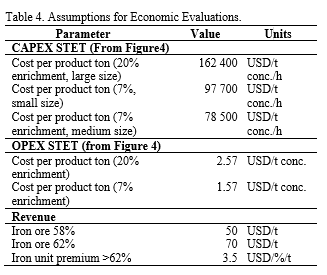 Vrijeme povrata procjenjuje se od prve godine proizvodnje. Za svaki projekt, dodatna dva (2) godine za izgradnju treba uzeti u obzir. Vrijednosti novčanog toka (Troškovi i prihodi) diskontirani su od početka gradnje.
Vrijeme povrata procjenjuje se od prve godine proizvodnje. Za svaki projekt, dodatna dva (2) godine za izgradnju treba uzeti u obzir. Vrijednosti novčanog toka (Troškovi i prihodi) diskontirani su od početka gradnje.
4.0 Proces dobročinstva u suhom radu DSO-a
Ruda za izravnu dostavu (DSO) Projekti proizvode najveću količinu željezne rude na svijetu, prvenstveno hrani kinesko tržište, a većina volumena dolazi iz Zapadne Australije (WA) i Brazil. U 2017, premašena je količina željezne rude proizvedene u WA 800 milijun tona i brazilski volumen je oko 350 milijuna tona [11]. Procesi dobročinstva su vrlo jednostavni, koji se uglavnom sastoji od drobljenja, pranje i razvrstavanje [12].
Beneficiation ultra-novčane kazne za generiranje 65% Fe koncentrat je prilika za DSO tržište. Pristup koji se primjenjuje za evaluaciju prednosti tehnologije STET za projekte ODS-a kompromis je između proizvodnje postojećih ultra-novčanih kazni za željezo niskog stupnja i alternativa proizvodnji proizvoda s dodanom vrijednošću nakon zaostajanja STET-a. Predložena tablica toka (Slika 5) smatra da je izmišljena operacija DSO-a u Wa-u koja bi trenutačno izvozila među svoje proizvode ultra novčane kazne na 58% Fe. Alternativa bi koncentrirala ultra-novčane kazne kako bi se povećala vrijednost konačnog proizvoda. Tablica 5 predstavlja neke od kriterija dizajna i masenu bilancu na visokoj razini koja se koristi pri procjeni prihoda. Orebody u smislu razreda i kapaciteta ne predstavlja postojeći projekt, već tipičan DSO projekt u smislu veličine i proizvodnje.
Tablica 5. Ultra-fini kriteriji dizajna postrojenja za beneficijenciju DSO i bilanca mase.
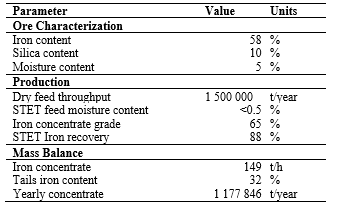
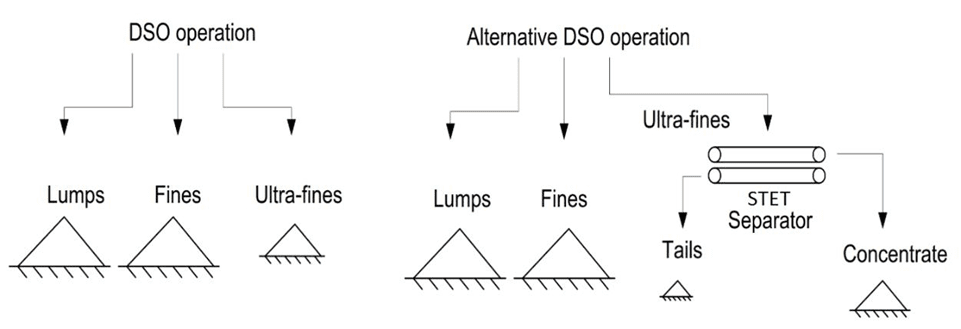
Slika 5. Listovi toka u usporedbi s kompromisom o ODS-u
Tablica 6 predstavlja CAPEX na visokoj razini, OPEX i procijenjeni prihodi. Procjena CAPEX-a uključuje dodavanje novog namjenskog sustava za učitavanje (silos za utovar i utovar automobila), kao i STET sustav. Kako bi se procijenio povrat predloženog dijagrama toka, ekonomska analiza provodi se oko kompromisa između slučaja dobročinstva i prodaje proizvoda niskog stupnja. U slučaju dobročinstva, volumen se smanjuje, ali premija na željezne jedinice značajno povećava prodajnu cijenu. U OPEX-u, predviđena je procjena za preradu rude uzvodno (Rudarstvo, Drobljenje, Razvrstavanje i rukovanje).
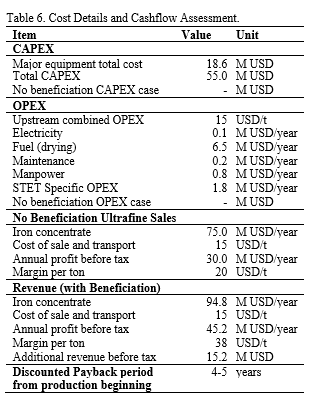
Unatoč značajnom smanjenju volumena, Povrat je zanimljiv s obzirom na premiju na koncentrat željezne rude visokog stupnja. Izračun povrata uvelike ovisi o ovoj premiji, koji je u posljednjih nekoliko godina u porastu zbog problema s okolišem. Kao što je gore prikazano (Tablica 6), Ekonomska privlačnost takvog projekta uvelike ovisi o razlici u cijeni između 58% željezo i 65% željezo. U ovoj trenutnoj evaluaciji, Ova premija cijena bila je 30.5 $/t, što odražava približno trenutačnu situaciju na tržištu. Međutim, Ova premija cijena povijesno se kretala od 15 – 50 $/t.
5.0 Proces čišćenja u gravitaciji
Postrojenje za odvajanje
Koncentratori željeza u regiji Sjeverne Amerike koriste koncentraciju gravitacije što je učinkovit način koncentracije hematita i magnetita, posebno za udio veličine iznad 75μm [5,13]. Hematit/magnetit biljke u ovoj regiji obično koriste spirale kao primarni proces odvajanja, a uključuju i korake magnetskog odvajanja niskog intenziteta (Lims (lims)). Čest problem u biljkama hematita / magnetita je oporaba finog željeza jer količine željeznih repova često dosežu razine do visokih 20%. Glavni izazov odnosi se na fini hematit, jer se fino željezo teško može oporaviti spiralama i otporno je na LIMS koji se koristi za oporavak finog magnetita. Nasuprot tome,, STET separator je vrlo učinkovit u odvajanju sitnih čestica, uključujući čestice ispod 20μm mikrona gdje su LIMS i spirale manje učinkovite. Stoga, preljev iz čišćeg hidrosajzera (Otežani doseljenik) hranjenje spirala čistača dobro odgovara STET tehnologiji. Predloženi dijagram toka prikazan je na slici 6.
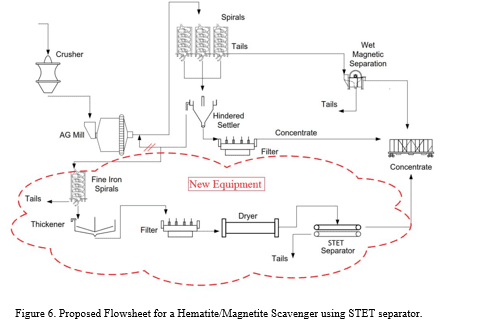
U ovoj konfiguraciji, Linija crvene crtice ističe novu opremu unutar postojećeg postrojenja. Prema predloženom dijagramu toka, umjesto da se recirkulira, Otežani preljev taložnika obrađivao bi se čišćenjem spirala koje rade u različitim uvjetima od grubljih spirala. Može se proizvesti i osušiti fini koncentrat željeza. Osušeni koncentrat tada bi bio usmjeren na STET separator kako bi se dobio konačni koncentrat salable razreda. Fini proizvod mogao bi se stavljati na tržište zasebno ili zajedno s preostalom proizvodnjom koncentratora.
Tablica 7 predstavlja kriterije dizajna i masenu bilancu na visokoj razini koja se koristi pri procjeni prihoda.
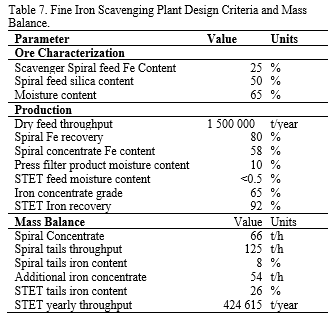
Tablica 8 predstavlja CAPEX na visokoj razini, OPEX i procijenjeni prihodi.
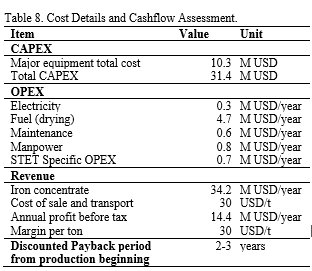
Ova analiza pokazuje da je povratak implementacije kruga za čišćenje koji uključuje STET tehnologiju atraktivan i zahtijeva daljnje razmatranje.
Još jedna prednost sušenja finog koncentrata željeza u usporedbi s konkurentnim tehnologijama je povezana korist koja proizlazi iz rukovanja materijalom nakon koncentracije. Vrlo fin mokri koncentrat problematičan je u pogledu filtriranja, rukovanje i prijevoz. Problemi sa smrzavanjem u vlakovima i fluksom u čamcima čine sušenje vrlo finog koncentrata ponekad obveznim. Stoga bi sušenje ugrađenim GET-om moglo postati povoljno.
6.0 Dobročinstvo brazilskih repova
Depozit
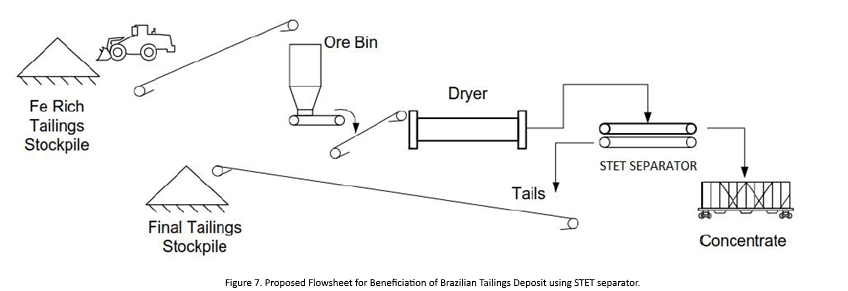 Beneficicija finih repova pojavljuje se kao aplikacija s dodanom vrijednošću za procesore za valorizaciju STET tehnologije, Budući da je resurs fino mljeven i dostupan za nisku cijenu. Dok su naslage željezne rude koje nose visoku razinu željeza prisutne na mnogim mjestima, lokacije na kojima je logistika jednostavna trebale bi imati prednost za daljnju procjenu. Brazilski depoziti koji sadrže visoke fe razrede i strateški smješteni u blizini postojeće prometne infrastrukture mogli bi predstavljati dobru priliku za prerađivače da iskoriste primjenu STET tribo-elektrostatičke tehnologije. Predložena tablica toka (Slika 7) smatra da je izmišljena brazilska operacija repova bogata Fe-om u kojoj bi tehnologija STET bila jedini proces dobročinstva.
Beneficicija finih repova pojavljuje se kao aplikacija s dodanom vrijednošću za procesore za valorizaciju STET tehnologije, Budući da je resurs fino mljeven i dostupan za nisku cijenu. Dok su naslage željezne rude koje nose visoku razinu željeza prisutne na mnogim mjestima, lokacije na kojima je logistika jednostavna trebale bi imati prednost za daljnju procjenu. Brazilski depoziti koji sadrže visoke fe razrede i strateški smješteni u blizini postojeće prometne infrastrukture mogli bi predstavljati dobru priliku za prerađivače da iskoriste primjenu STET tribo-elektrostatičke tehnologije. Predložena tablica toka (Slika 7) smatra da je izmišljena brazilska operacija repova bogata Fe-om u kojoj bi tehnologija STET bila jedini proces dobročinstva.
Smatra se da je depozit dovoljno velik da osigura desetljeća hrane po godišnjoj stopi od 1.5 M tona/godina. Za ovaj scenarij, krmna ruda je već fino mljevena s D50 od ~ 50μm i rudača bi trebala biti lopata, transportiran, a zatim osušen prije tribo-elektrostatičke dobročinstva. Koncentrat bi se zatim utovarivao u vlakove/brodove, a novi repovi gomilali bi se u novom objektu.
Tablica 9 predstavlja kriterije dizajna i masenu bilancu na visokoj razini koja se koristi pri procjeni prihoda. Tablica 10 predstavlja CAPEX na visokoj razini, OPEX i procijenjeni prihodi.
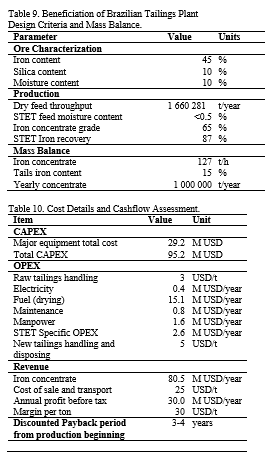 Kao što je prikazano u tablici 10, povratak primjene STET tehnologije za dobročinstvo brazilskih repova privlačan je. Osim toga, S ekološkog stajališta, predloženi dijagram toka također je koristan u mjeri u kojoj bi se dobročinstvom suhih repova, smanjila veličina i površina repova te smanjili rizici povezani s odlaganjem mokrih repova.
Kao što je prikazano u tablici 10, povratak primjene STET tehnologije za dobročinstvo brazilskih repova privlačan je. Osim toga, S ekološkog stajališta, predloženi dijagram toka također je koristan u mjeri u kojoj bi se dobročinstvom suhih repova, smanjila veličina i površina repova te smanjili rizici povezani s odlaganjem mokrih repova.
7.0 Rasprava i preporuke
STET separator uspješno je demonstriran na klupi kako bi se odvojila fina željezna ruda, stoga se prerađivačima nudi nova metoda za povrat novčanih kazni koje bi inače bilo teško obraditi za prodajne razrede s postojećim tehnologijama.
Listovi toka koje su procijenili STET i Soutex primjeri su obrade željezne rude koji mogu imati koristi od suhog odvajanja triboelektrostata. Njih troje (3) Razvijeni listovi toka predstavljeni u ovoj studiji nisu isključivi i treba razmotriti druge alternative. Ova preliminarna studija pokazuje da procesi čišćenja koji uključuju niske troškove sušenja, DSO operacije i dobročinstvo repova imaju dobre šanse za komercijalni uspjeh.
Još jedna prednost u suhoj obradi je skladištenje repova - koji se trenutno skladište u ogromnim ribnjacima s repovima – jer bi suhi repovi imali prednost u uklanjanju važnog rizika za okoliš. Nedavni i dobro objavljeni kvarovi brane na repovima ukazuju na potrebu za upravljanjem repovima.
Ulazi u ovu studiju korišteni za izračunavanje stupnja i oporavka željezne rude bili su rezultati odvajanja stolne vage pomoću uzoraka željezne rude iz više regija. Međutim, Mineralogija i oslobodilačke karakteristike svake rude su jedinstvene, Stoga uzorke željezne rude kupca treba ocjenjivati na klupi ili pilotskoj skali. U sljedećem koraku razvoja, Tri lista toka ocijenjena u ovom radu treba detaljnije proučiti.
Konačno, trenutno se proučavaju druge tehnologije za finu oporabu željeza kao što je WHIMS, Klasifikatori jigova i refluksa. Već je poznato da mnogi procesi odvajanja mokrih tvari postaju neučinkoviti za čestice ispod 45 μm i stoga bi STET tehnologija mogla imati prednost u vrlo finom rasponu, kao STET je vidio dobre performanse s feedom finim kao 1μm. Trebalo bi provesti službenu studiju kompromisa koja uspoređuje navedene tehnologije sa STET-om, što bi uključivalo procjenu uspješnosti, Kapacitet, koštati, itd. Na taj bi se način mogla istaknuti i usavršiti najbolja niša za STET.
Reference
1. Lu, L. (Ed.) (2015), "Željezna ruda: Mineralogija, Prerada i održivost okoliša", Elsevier.
2. Ferreira, H., & Leite, M. G. P. (2015), "Studija procjene životnog ciklusa rudarstva željezne rude", Časopis za čišću proizvodnju, 108, pp. 1081-1091.
3. Filippov, L. O., Severov, V. V., & Filippova, Ja. V. (2014), "Pregled dobročinstva željeznih ruda putem obrnute kationske flotacije", Međunarodni časopis za preradu minerala, 127, pp. 62-69.
4. Sahoo, H., Rath, S. S., Rao, D. S., Mishra, B. K., & Ba5, B. (2016), "Uloga sadržaja silicijevog dioksida i glinice u flotaciji željeznih ruda", Međunarodni časopis za preradu minerala, 148, pp. 83-91.
5. Bazin, Claude, i dr. (2014), “Krivulje povrata veličine minerala u industrijskim spiralama za preradu ruda željeznog oksida.” Minerali Inženjering 65, pp 115-123.
6. Luo, X., Wang, Y., Wen, S., Mama, M., Sunce, C., Yin, W., & Mama, Y. (2016), "Utjecaj karbonatnih minerala na ponašanje kvarcne flotacije u uvjetima obrnute anionske flotacije željeznih ruda", Međunarodni časopis za preradu minerala, 152, pp. 1-6.
7. Da Silva, F. L., Araújo, F. G. S., Teixeira, M. P., Gomes, R.C., & Von Krüger, F. L. (2014), "Studija oporabe i recikliranja repova iz koncentracije željezne rude za proizvodnju keramike", Keramika International, 40(10), pp. 16085-16089.
8. Bielitza, Marko P.. (2012), “Izgledi za 2020 Tržnica željezne rude. Kvantitativna analiza tržišne dinamike i strategija ublažavanja rizika” Knjige, Rainer Hampp Verlag, izdanje 1, broj 9783866186798, Jan-Jun.
9. Rojas-Mendoza, L. F. Hrach, K. Flynn i A. Gupta. (2019), "Suho dobročinstvo novčanih kazni od željezne rude niskog stupnja pomoću tribo-električnog separatora remena", U zborniku radova na godišnjoj konferenciji za MSP-ove & Expo i CMA 121. nacionalna zapadna rudarska konferencija Denver, Colorado – veljača 24-27, 2019.
10. Kineski indeks spot cijena željezne rude (CSI). Dohvaćeno iz http://www.custeel.com/en/price.jsp
11. SAD. Geološko istraživanje (USGS) (2018), "Željezna ruda", u željeznoj rudi Statistika i informacije.
12. Janković, A. (2015), "Razvoj tehnologija komminacije i klasifikacije željezne rude. Željezne rude. http://dx.doi.org/10.1016/B978-1-78242-156-6.00008-3.
Elsevier d.o.o..
13. Richards, R. G., i dr.. (2000), “Gravitacijsko odvajanje ultra-fine (− 0.1 mm) minerali koji koriste spiralne separatore.” Minerali Inženjering 13.1, pp. 65-77.